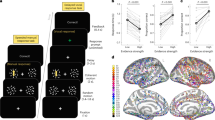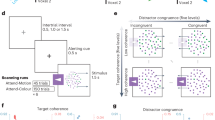Abstract
When confronted with complex inputs consisting of multiple elements, humans use various strategies to integrate the elements quickly and accurately. For instance, accuracy may be improved by processing elements one at a time1,2,3,4 or over extended periods5,6,7,8; speed can increase if the internal representation of elements is accelerated9,10. However, little is known about how humans actually approach these challenges because behavioural findings can be accounted for by multiple alternative process models11 and neuroimaging investigations typically rely on haemodynamic signals that change too slowly. Consequently, to uncover the fast neural dynamics that support information integration, we decoded magnetoencephalographic signals that were recorded as human subjects performed a complex decision task. Our findings reveal three sources of individual differences in the temporal structure of the integration process—sequential representation, partial reinstatement and early computation—each having a dissociable effect on how subjects handled problem complexity and temporal constraints. Our findings shed new light on the structure and influence of self-determined neural integration processes.
This is a preview of subscription content, access via your institution
Access options
Access Nature and 54 other Nature Portfolio journals
Get Nature+, our best-value online-access subscription
$29.99 / 30 days
cancel any time
Subscribe to this journal
Receive 12 digital issues and online access to articles
$119.00 per year
only $9.92 per issue
Buy this article
- Purchase on Springer Link
- Instant access to full article PDF
Prices may be subject to local taxes which are calculated during checkout




Similar content being viewed by others
References
Rumelhart, D. E. & McClelland, J. L. Parallel Distributed Processing: Explorations in the Microstructure of Cognition (MIT Press, Cambridge, MA, 1986).
Treisman, A. M. Strategies and models of selective attention. Psychol. Rev. 76, 282–299 (1969).
Bergen, J. R. & Julesz, B. Parallel versus serial processing in rapid pattern discrimination. Nature 303, 696–698 (1983).
Feng, S. F., Schwemmer, M., Gershman, S. J. & Cohen, J. D. Multitasking versus multiplexing: toward a normative account of limitations in the simultaneous execution of control-demanding behaviors. Cogn. Affect. Behav. Neurosci. 14, 129–146 (2014).
Gold, J. I. & Shadlen, M. N. The neural basis of decision making. Annu. Rev. Neurosci. 30, 535–574 (2007).
Heitz, R. P. & Schall, J. D. Neural mechanisms of speed–accuracy tradeoff. Neuron 76, 616–628 (2012).
Hanks, T., Kiani, R. & Shadlen, M. N. A neural mechanism of speed–accuracy tradeoff in macaque area LIP. eLife 3, e02260 (2014).
Hawkins, G. E., Forstmann, B. U., Wagenmakers, E. J., Ratcliff, R. & Brown, S. D. Revisiting the evidence for collapsing boundaries and urgency signals in perceptual decision-making. J. Neurosci. 35, 2476–2484 (2015).
Marti, S., King, J. R. & Dehaene, S. Time-resolved decoding of two processing chains during dual-task interference. Neuron 88, 1297–1307 (2015).
Chalk, M., Marre, O. & Tkačik, G. Toward a unified theory of efficient, predictive, and sparse coding. Proc. Natl Acad. Sci. USA 115, 186–191 (2018).
Williams, P., Eidels, A. & Townsend, J. T. The resurrection of Tweedledum and Tweedledee: bimodality cannot distinguish serial and parallel processes. Psychon. Bull. Rev. 21, 1165–1173 (2014).
Carlson, T., Tovar, D. A., Alink, A. & Kriegeskorte, N. Representational dynamics of object vision: the first 1000 ms. J. Vis. 13, 1 (2013).
Isik, L., Meyers, E. M., Leibo, J. Z. & Poggio, T. The dynamics of invariant object recognition in the human visual system. J. Neurophysiol. 111, 91–102 (2014).
Cichy, R. M., Pantazis, D. & Oliva, A. Resolving human object recognition in space and time. Nat. Neurosci. 17, 455–462 (2014).
Kurth-Nelson, Z., Barnes, G., Sejdinovic, D., Dolan, R. & Dayan, P. Temporal structure in associative retrieval. eLife 4, e04919 (2015).
Kurth-Nelson, Z., Economides, M., Dolan, R. J. & Dayan, P. Fast sequences of non-spatial state representations in humans. Neuron 91, 194–204 (2016).
Hunt, L. T. et al. Mechanisms underlying cortical activity during value-guided choice. Nat. Neurosci. 15, 470–476 (2012).
Hotelling, H. Relations between two sets of variates. Biometrika 28, 321–377 (1936).
Simon, H. A. Models of Bounded Rationality: Empirically Grounded Economic Reason (MIT Press, Cambridge, MA, 1982).
Howes, A., Vera, A., Lewis, R. L. & McCurdy, M. Cognitive constraint modeling: a formal approach to supporting reasoning about behavior. In Proc. 26th Annual Meeting of the Cognitive Science Society (eds Forbus, K., Gentner, D. & Regier, T.) 595–600 (Lawrence Erlbaum, 2004).
Wickelgren, W. A. Speed–accuracy tradeoff and information processing dynamics. Acta Psychol. 41, 67–85 (1977).
Krajbich, I., Armel, C. & Rangel, A. Visual fixations and the computation and comparison of value in simple choice. Nat. Neurosci. 13, 1292–1298 (2010).
Dai, J. & Busemeyer, J. R. A probabilistic, dynamic, and attribute-wise model of intertemporal choice. J. Exp. Psychol. Gen. 143, 1489–1514 (2014).
Rich, E. L. & Wallis, J. D. Decoding subjective decisions from orbitofrontal cortex. Nat. Neurosci. 19, 973–980 (2016).
Townsend, J. T. & Wenger, M. J. The serial-parallel dilemma: a case study in a linkage of theory and method. Psychon. Bull. Rev. 11, 391–418 (2004).
Sternberg, R. J. & Grigorenko, E. L. Are cognitive styles still in style? Am. Psychol. 52, 700–712 (1997).
Rayner, S. & Riding, R. Towards a categorisation of cognitive styles and learning styles. Educ. Psychol. 17, 5–27 (1997).
Nisbett, R. E., Peng, K., Choi, I. & Norenzayan, A. Culture and systems of thought: holistic versus analytic cognition. Psychol. Rev. 108, 291–310 (2001).
Felder, R. M. & Spurlin, J. Applications, reliability and validity of the index of learning styles. Int. J. Eng. Educ. 21, 103–112 (2005).
Choi, I., Koo, M. & Choi, J. A. Individual differences in analytic versus holistic thinking. Pers. Soc. Psychol. Bull. 33, 691–705 (2007).
Kozhevnikov, M. Cognitive styles in the context of modern psychology: toward an integrated framework of cognitive style. Psychol. Bull. 133, 464–481 (2007).
Eldar, E., Cohen, J. D. & Niv, Y. The effects of neural gain on attention and learning. Nat. Neurosci. 16, 1146–1153 (2013).
Montague, P. R., Dolan, R. J., Friston, K. J. & Dayan, P. Computational psychiatry. Trends Cogn. Sci. 16, 72–80 (2012).
Wang, X. J. & Krystal, J. H. Computational psychiatry. Neuron 84, 638–654 (2014).
Eldar, E. & Niv, Y. Interaction between emotional state and learning underlies mood instability. Nat. Commun. 6, 6149 (2015).
Eldar, E., Hauser, T. U., Dayan, P. & Dolan, R. J. Striatal structure and function predict individual biases in learning to avoid pain. Proc. Natl Acad. Sci. USA 113, 4812–4817 (2016).
Schwarz, G. Estimating the dimension of a model. Ann. Stat. 6, 461–464 (1978).
Bishop, C. M. Pattern Recognition and Machine Learning (Springer, Heidelberg, 2006)..
Kass, R. E. & Raftery, A. E. Bayes factors. J. Am. Stat. Assoc. 90, 773–795 (1995).
Huys, Q. J. et al. Bonsai trees in your head: how the Pavlovian system sculpts goal-directed choices by pruning decision trees. PLoS Comp. Biol. 8, e1002410 (2012).
Oostenveld, R., Fries, P., Maris, E. & Schoffelen, J. M. FieldTrip: open source software for advanced analysis of MEG, EEG, and invasive electrophysiological data. Comput. Intell. Neurosci. 2011, 156869 (2011).
Sun, L., Ji, S. & Ye, J. Canonical correlation analysis for multilabel classification: a least-squares formulation, extensions, and analysis. IEEE Trans. Pattern Anal. Mach. Intell. 33, 194–200 (2011).
Hoffman, K. L. & McNaughton, B. L. Coordinated reactivation of distributed memory traces in primate neocortex. Science 297, 2070–2073 (2002).
Busch, N. & VanRullen, R. in Subjective Time: The Philosophy, Psychology, and Neuroscience of Temporality (eds Arstila, V. & Lloyd. D.) 161–178 (MIT Press, Cambridge, MA, 2014).
Maris, E. & Oostenveld, R. Nonparametric statistical testing of EEG- and MEG-data. J. Neurosci. Methods 164, 177–190 (2007).
Kessels, R. P., Van Zandvoort, M. J., Postma, A., Kappelle, L. J. & De Haan, E. H. The Corsi block-tapping task: standardization and normative data. Appl. Neuropsychol. 7, 252–258 (2000).
Wechsler, D. & Hsiao-pin, C. WASI-II: Wechsler Abbreviated Scale of Intelligence (Pearson, San Antonio, TX, 2011).
Hoekstra, R. A. et al. The construction and validation of an abridged version of the autism-spectrum quotient (AQ-Short). J. Autism Dev. Disord. 41, 589–596 (2011).
Kessler, R. C. et al. The World Health Organization adult ADHD self-report scale (ASRS): a short screening scale for use in the general population. Psychol. Med. 35, 245–256 (2005).
Acknowledgements
This work was funded by the Wellcome Trust’s Cambridge–University College London Mental Health and Neurosciences Network grant 095844/Z/11/Z (E.E. and R.J.D.), the Wellcome Trust Investigator Award 098362/Z/12/Z (R.J.D.), the Gatsby Charitable Foundation (P.D.) and the Max Planck Society (Z.K.-N.). The Max Planck University College London Centre is a joint initiative supported by University College London and the Max Planck Society. The funders had no role in study design, data collection and analysis, decision to publish or preparation of the manuscript. We thank T. E. Behrens and R. Moran for helpful feedback on previous versions of this manuscript.
Author information
Authors and Affiliations
Contributions
E.E. conceptualized the study. E.E., G.J.B., Z.K.-N. and P.D. conceptualized the methodology. E.E. and G.J.B. undertook the investigation. E.E. wrote the original draft of the paper. E.E., Z.K.-N., P.D. and R.J.D. reviewed and edited the paper. R.J.D. acquired funding. P.D. and R.J.D. supervised the study.
Corresponding author
Ethics declarations
Competing interests
The authors declare no competing interests.
Additional information
Publisher’s note: Springer Nature remains neutral with regard to jurisdictional claims in published maps and institutional affiliations.
Supplementary information
Supplementary Information
Supplementary Figures 1–12, Supplementary Table 1, Supplementary References
Rights and permissions
About this article
Cite this article
Eldar, E., Bae, G.J., Kurth-Nelson, Z. et al. Magnetoencephalography decoding reveals structural differences within integrative decision processes. Nat Hum Behav 2, 670–681 (2018). https://doi.org/10.1038/s41562-018-0423-3
Received:
Accepted:
Published:
Issue Date:
DOI: https://doi.org/10.1038/s41562-018-0423-3
This article is cited by
-
Heuristics in risky decision-making relate to preferential representation of information
Nature Communications (2024)
-
Decoding cognition from spontaneous neural activity
Nature Reviews Neuroscience (2022)
-
Healthful choices depend on the latency and rate of information accumulation
Nature Human Behaviour (2021)
-
Dissociable mechanisms govern when and how strongly reward attributes affect decisions
Nature Human Behaviour (2020)
-
Queuing cues in rapid cortical processing
Nature Human Behaviour (2018)



